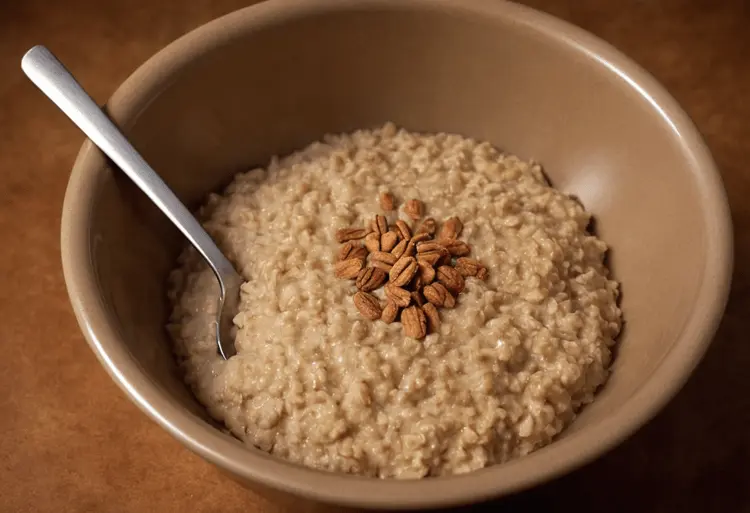CRAM Diet: Upset stomach got you feeling like a crumpled piece of paper? Whether it’s a stomach bug, food poisoning, or just a case of the queasies, digestive distress is no fun. But hold on, there’s a simple, time-tested solution that could be your gut’s best friend – the CRAM diet.
What’s the CRAM Diet, you ask? It’s a bland diet yet effective eating plan featuring Cereal, Rice, Applesauce, and Milk. These gentle foods to eat on CRAM diet give your digestive system a break while providing essential nutrients and hydration.
Unlike the BRAT diet, which can leave you feeling hungry and deprived, the CRAM diet offers more variety and flavor. Think comforting bowls of oatmeal, creamy rice pudding, and soothing applesauce.
Plus, you get the added benefit of milk for protein and fat, crucial for energy and recovery.
So, if you’re searching for an upset stomach diet, a gastroenteritis diet, or a simple bland diet for diarrhea, this diet might be the answer. Keep reading to learn how this easy-to-follow this diet meal plan can help you bounce back faster and feel like yourself again.
CRAM Diet in a Nutshell
- Upset stomach soother
- Cereal, Rice, Applesauce, Milk
- Gentle on digestion
- More nutritious than BRAT
- Temporary relief
Table of contents
Introduction to the CRAM Diet

What is the CRAM Diet?
Have you ever experienced a bout of diarrhea or an upset stomach so severe that the mere thought of food made you queasy? If so, the CRAM diet might be your new best friend.
CRAM, which stands for Cereal, Rice, Applesauce, and Milk, is a temporary dietary intervention designed to soothe your digestive system and speed up recovery from tummy troubles. It’s a simple, bland diet that’s easy on the stomach, allowing it to rest and heal.
But what makes this diet a better choice than the well-known BRAT (Bananas, Rice, Applesauce, Toast) diet? The CRAM diet offers a broader range of nutrients, including fat and protein, which are essential for recovery.
Plus, it allows for more variety in your meals, making it easier to stick to the plan.
Who Can Benefit from the CRAM Diet?
The CRAM diet is a versatile tool in your health arsenal. It’s suitable for both adults and children experiencing diarrhea, upset stomach, or vomiting.
According to the World Health Organization, diarrhea is the second leading cause of death in children under five worldwide, highlighting the importance of dietary interventions like the CRAM diet.
Pregnant and breastfeeding women can also benefit from this diet, but it’s essential to consult with a healthcare provider to ensure it meets their specific nutritional needs.
Why Choose CRAM?
This diet isn’t just about bland food. It’s about providing your body with the right kind of nourishment when it’s most vulnerable.
The Academy of Nutrition and Dietetics suggests that this diet can be a helpful tool in managing diarrhea due to its binding effect and ease of digestion.
Remember, while this diet is a valuable tool, it’s not a substitute for medical advice. If your symptoms persist or worsen, it’s crucial to seek professional guidance.
We’d love to hear your thoughts on the CRAM diet! Have you tried it before? Share your experiences in the comments below or tag us on social media. Your insights could help others on their journey to better gut health
Craving more than just cereal, rice, applesauce, and milk? Spice up your recovery with our Ultimate Bland Diet Food List! Discover delicious and gut-friendly options to expand your CRAM diet horizons and keep your taste buds happy.
The Science Behind the CRAM Diet
Ever wondered how the seemingly simple CRAM diet can quell an upset stomach and tame diarrhea? Let’s dive into the science behind it.
Binding & Firming: The CRAM Diet’s Secret Weapon
First and foremost, the CRAM diet shines due to its binding properties. Foods like rice and applesauce contain soluble fiber, which absorbs water in your gut. This helps firm up loose stools, offering much-needed relief from diarrhea. Remember, consistency is key!
Gentle on the Gut: Easy Digestion for Quick Recovery
Secondly, this diet is all about easily digestible foods. Unlike greasy burgers or spicy curries, the bland nature of cereals, rice, applesauce, and milk gives your digestive system a break.
This allows your body to focus on healing, promoting a quicker recovery. As the Academy of Nutrition and Dietetics suggests, this gentle approach is crucial for those experiencing gastrointestinal distress.
Hydration Station: Milk & Applesauce to the Rescue
Dehydration is a major concern when dealing with stomach bugs or diarrhea. This diet’s inclusion of milk and applesauce is strategic, as they’re packed with fluids and electrolytes.
These help replenish your body’s water and mineral levels, keeping you hydrated while you recover.
Nutritional Powerhouse: The CRAM Diet’s Hidden Strength
While the CRAM diet is temporary, it’s not devoid of nutrients. Milk provides protein and calcium, while applesauce offers vitamins and fiber. Even the refined grains in cereal offer small amounts of B vitamins and iron.
It’s a balancing act between soothing your gut and providing essential nutrients. Remember to consult the World Health Organization’s guidelines on managing diarrhea to ensure proper hydration and nutrition during recovery.
The CRAM Diet Food List & Meal Plan
Ready to explore this diet menu? Let’s dive into the core foods that make this diet so effective for soothing upset stomachs and promoting recovery.
Core CRAM Diet Foods: Simple, Yet Strategic
- Cereal: Think bland, low-fiber options like Cream of Wheat or Rice Chex. These are easy to digest and won’t irritate your gut.
- Rice: Stick to white rice for now. It’s gentle on your digestive system and helps firm up stool.
- Applesauce: Choose unsweetened applesauce to avoid excess sugar, which can worsen diarrhea.
- Milk: Opt for whole or low-fat milk, as it provides essential nutrients like calcium and protein while keeping you hydrated.
Remember, this diet is a temporary measure to support your body during digestive distress.
The Academy of Nutrition and Dietetics suggests that this diet can be a helpful tool, but it’s important to consult with your doctor or a registered dietitian to ensure it’s the right fit for you.
Expanding Your CRAM Diet Plate: More Options for Flavor and Nutrition
Now, let’s spice things up a bit! In addition to the core CRAM foods, you can gradually introduce other bland, easily digestible options:
- Bananas: These are a great source of potassium, an electrolyte you might lose due to diarrhea.
- Toast: White bread is preferred, as it’s lower in fiber than whole-wheat varieties.
- Saltine Crackers: These can help settle your stomach and provide some sodium.
- Broths: Clear broths like chicken or vegetable broth can replenish fluids and electrolytes.
- Potatoes: Boiled or baked potatoes are gentle on the stomach and offer additional carbohydrates for energy.
Remember, the key is to listen to your body and introduce new foods slowly.
Foods to Steer Clear Of: Your CRAM Diet “No-No” List
While this diet is relatively flexible, some foods are best avoided while you’re recovering:
- Dairy (except milk): Cheese, yogurt, and ice cream can be harder to digest.
- Fatty or fried foods: These can trigger stomach upset and worsen diarrhea.
- Sugary foods and drinks: Sugar can irritate your gut and draw water into your intestines, exacerbating diarrhea.
- Spicy foods: Spices can further inflame your digestive system.
- Caffeine: This stimulant can dehydrate you and potentially worsen diarrhea.
- Alcohol: Alcohol irritates your gut lining and should be avoided during recovery.
CRAM Diet Modifications & Considerations

A Personalized CRAM Diet? Absolutely!
The CRAM diet isn’t one-size-fits-all. It can be tailored to your needs. Got little ones? Expecting? Managing diabetes? We’ve got you covered.
Infants & Young Children: A Gentle Approach
Ever wondered, “Can my baby follow this diet?” The answer is yes, but with tweaks! Breastfed infants can continue nursing, while formula-fed babies may need lactose-free options. Toddlers can nibble on plain crackers and mashed bananas.
Pregnant & Breastfeeding: Nourishing Two
The CRAM diet is generally safe during pregnancy and breastfeeding, providing essential fluids and electrolytes. But, it’s crucial to stay hydrated and consult your doctor if symptoms persist.
As the Academy of Nutrition and Dietetics suggests, the CRAM diet can be a helpful tool for managing symptoms like diarrhea. But, individual needs can vary, so personalized guidance is key.
Diabetes & The CRAM Diet: A Balancing Act
Balancing blood sugar on the CRAM diet? It’s doable! Choose unsweetened applesauce, limit rice, and monitor glucose levels. This ensures the diet supports recovery without impacting your blood sugar.
Food Allergies & Intolerances: Finding Alternatives
Lactose intolerance? Swap milk for lactose-free options or fortified plant-based milk. Gluten allergy? Opt for gluten-free cereal. There’s always a way to modify this diet to fit your unique dietary needs.
The National Institute of Diabetes and Digestive and Kidney Diseases provides a list of warning signs for when to seek medical attention, ensuring a safe and effective experience with this diet.
Nutritional Information: A Closer Look
This diet isn’t just about bland foods. It can offer essential nutrients! Applesauce delivers vitamin C, milk provides calcium, and rice offers carbohydrates for energy.
Let’s Get Personal!
Have questions or a unique situation? We’re here for you! Share your experiences or tag us on social media using #CRAMDiet. We’d love to hear how you’ve made the CRAM diet work for you.
CRAM Diet: What Could Go Wrong?
The CRAM diet isn’t a magic bullet for all tummy troubles. While it helps many people manage diarrhea and recover faster, it’s not risk-free.
Let’s chat about potential drawbacks and how to keep your gut health top of mind. Have you ever tried the CRAM diet and experienced any unexpected side effects?
Nutritional Limitations & Short-Term Use Only
First things first, this diet is intentionally limited in nutrients. It’s designed for a short-term recovery phase, not a sustainable long-term eating plan.
Why is this important? Well, your body craves a balanced mix of nutrients, including protein, healthy fats, and various vitamins and minerals, for optimal function.
The Academy of Nutrition and Dietetics suggests that this diet can be a helpful tool, but should not be followed for an extended period due to its limited nutritional profile.
Effectiveness Varies from Person to Person
Secondly, it’s crucial to remember that the CRAM diet won’t be effective for everyone. It’s simply one tool in the toolbox for managing digestive issues.
Do you have any underlying health conditions, such as diabetes or food allergies? If so, it’s important to talk to your doctor about tailoring the CRAM diet to your unique needs.
The National Institute of Diabetes and Digestive and Kidney Diseases provides a list of warning signs that may indicate a need for medical attention.
Watch Out for Low Fiber and Sugar Content
The CRAM diet is low in fiber, which can actually worsen constipation in some cases. Additionally, the sugar content in applesauce and refined grains can cause blood sugar spikes in individuals with diabetes.
Nourish Your Gut Beyond the CRAM Diet

So, the CRAM diet is done – now what? Remember, it’s a temporary solution, not a long-term eating plan. Transitioning back to your usual diet is key, but take it slow. Start by gradually adding in easy-to-digest foods.
The CRAM diet’s blandness got you down? It’s time to focus on nutrient-rich foods that will truly heal your gut. The Academy of Nutrition and Dietetics suggests a balanced diet with plenty of fluids is essential for long-term gut health.
Probiotics and prebiotics are your gut’s best friends. Yogurt, kefir, sauerkraut, and even dark chocolate can be your allies in rebuilding a healthy microbiome after this diet.
Nutrition Beyond Bland:
- Hydration is Key: Water, broth, herbal teas – keep those fluids flowing.
- Fiber Power: Slowly introduce high-fiber foods like fruits, vegetables, and whole grains.
- Protein Punch: Lean meats, fish, eggs, and legumes will help you regain strength.
- Don’t Forget the Fats: Healthy fats from avocados, nuts, and olive oil are essential for gut health.
Your gut health journey doesn’t end here. The CRAM diet is just one tool in your toolbox. Keep learning, experimenting, and listening to your body.
If you experience persistent digestive issues, remember the National Institute of Diabetes and Digestive and Kidney Diseases provides resources and guidance to help you.
Share Your CRAM Diet Experience!
We’d love to hear from you! How did the CRAM diet work for you? Share your tips, recipes, and success stories in the comments below, or tag us on social media. Let’s create a supportive community to help everyone thrive!
Craving creamy comfort but loved the CRAM diet’s gentle touch? Explore dairy-free delights that won’t upset your stomach! “Dairy-Free Meals” awaits, packed with flavor and gut-friendly goodness.
Your Burning CRAM Diet Questions Answered
Let’s tackle those niggling questions you might have about the CRAM diet. Got more? Drop a comment below, and I’ll help you out!
The CRAM diet adds milk for protein and fat, making it more nutritious than the BRAT diet. It also allows a wider variety of foods like saltine crackers and potatoes.
The BRAT diet consists of bananas, rice, applesauce, and toast.
Once your symptoms improve, gradually reintroduce easy-to-digest foods like cooked vegetables, plain yogurt, and lean proteins.
Ideally, stick to the CRAM diet for a maximum of 48 hours. This is usually enough time for your gut to rest and recover. If symptoms persist, see your doctor.
Absolutely! Herbs and spices like ginger or cinnamon can add flavor and may even aid digestion. Just remember to keep it mild.
Lactose-free milk is a great substitute! As the Academy of Nutrition and Dietetics suggests, you can also explore dairy-free alternatives like almond milk or rice milk.
You bet! The BRAT diet is similar, but the CRAM diet wins out for its nutritional value. You can also try the bland diet for a wider variety of foods.